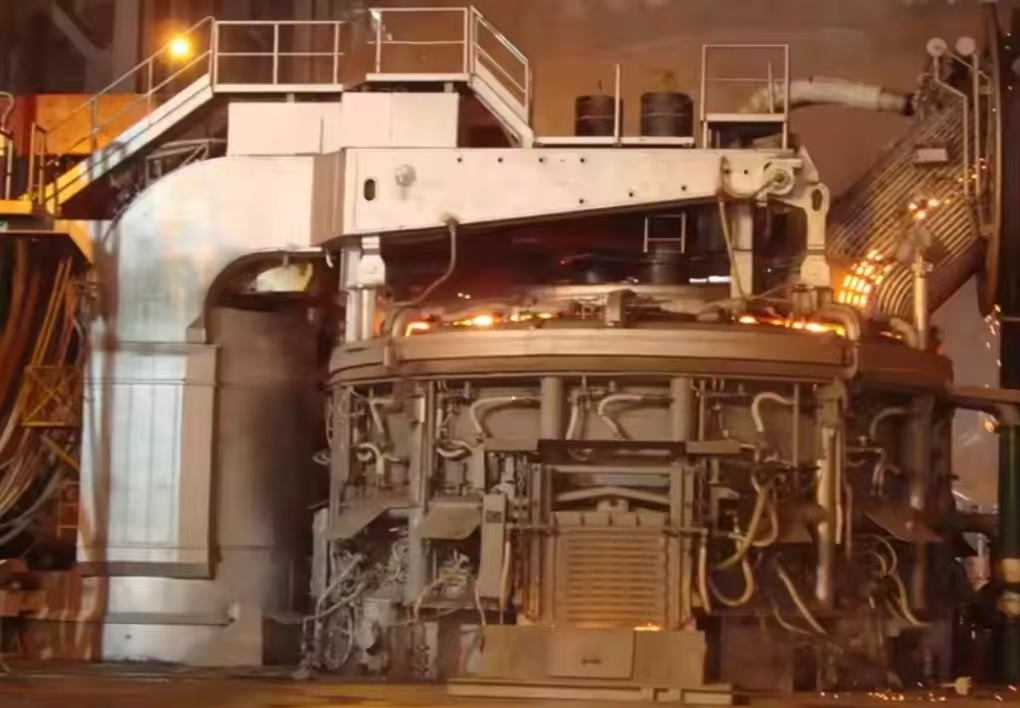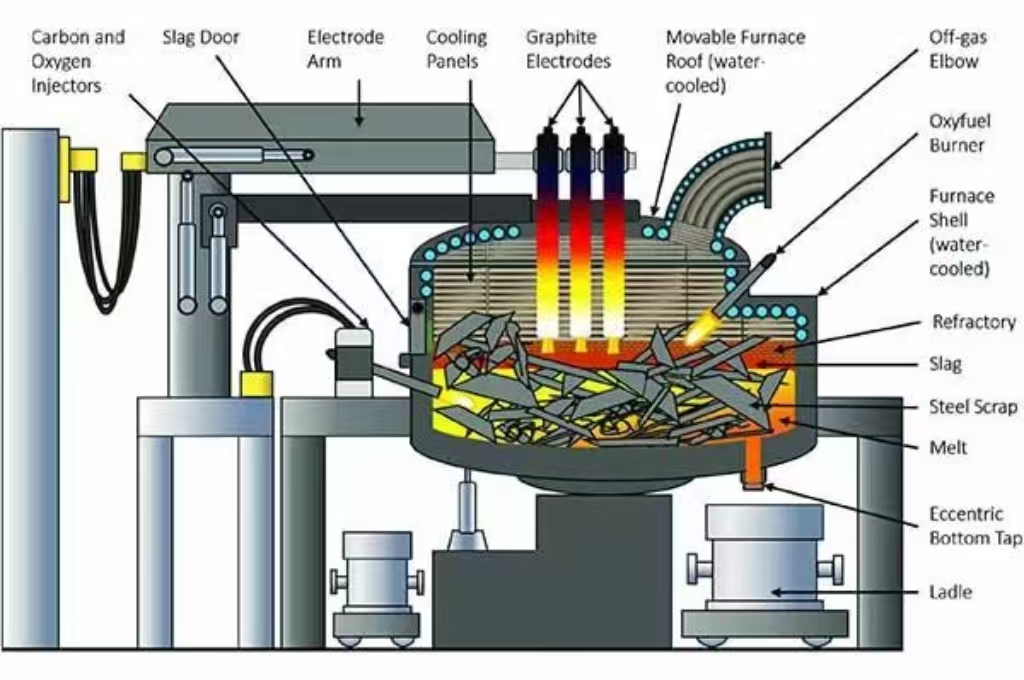電気アーク炉は工業的製鋼において非常に重要である。95%以上の電気鋼が電気アーク炉で製造されています。このブログでは、電気アーク炉の仕組み、構成部品とその利点、使用される重要な電気アーク炉材料、さらに電気アーク炉と他のタイプの炉との比較について説明します。
目次
トグル何 電気アーク炉(EAF)とは何か?
電気アーク炉(Electric Arc Furnace、EAF)は、電気アークで金属を高温で溶解する炉で、特に鉄鋼の溶解に用いられる。 EAF電極群は、電気アークを発生させて熱を発生させ、装入金属を溶融する。 石炭焚き高炉に比べ、電気アーク炉は年間を通じて柔軟性があり、よりクリーンである。 電気アーク炉による鉄鋼生産は資源効率に優れており、鉄源と比較して廃棄物を最小限に抑え、リサイクル材料の使用も可能です。
リサイクル可能な鉄スクラップは、ミニミルのEAF炉で処理される。このような原料投入の柔軟性により、EAFは環境にやさしく経済的な鉄鋼製造に理想的な設備として位置づけられている。ストライプ鋳造は、幅広い組成と高品質の鋼を供給できるため、特殊鋼や特殊合金に適しています。
電気アーク炉の仕組み
-
充電
電気アーク炉のプロセスの最初の部分は、装入、つまり原料を炉に投入することです。鉄スクラップ、銑鉄、場合によっては直接還元鉄(DRI)を主原料として使用します。これらの原料は装入装置によって炉に導入されます。最近の装入装置の進歩により、高水準の自動化が達成されつつあり、正確かつ効果的な化学組成で原料を添加することが可能になっている。バスケット」と呼ばれる大きな容器にスクラップを装入し、同時に、あるいはコンベアを介して連続的に炉に投入するバッチ装入も可能である。
-
メルティング
炉が充電されると、次は溶解が行われる。このプロセスでは、電極(グラファイトベースの材料の代わり)を炉に入れ、高電圧を通します。これにより電気アークが発生し、金属が溶けるところまで過熱される。電気炉自体の温度は3,500℃にもなり、金属スクラップやその他の原料を溶かすには十分すぎるほどです。電気炉はアークを利用し、電極と装入物の間に発生する熱を利用します。スラグシステムは最高の溶解スループットを提供するカバーとしてリムピッド層の助けを借りて溶融浴の化学組成を保護します。
-
精製
次の段階は、金属が溶けたら精錬することである。精錬とは、患者の溶けた状態の金属を精製するプロセスである。精錬中、酸素は通常、ランスを通して炉に吹き込まれ、炭素、リン、硫黄などの不純物を酸化させて除去する。高濃度の不純物は、石灰や蛍石のような他のフラックス材料と混合され、金属から不純物を捕捉するスラグを形成する。通常、様々な高度なセンサーと制御システムによって制御されるこの機能は、ユニークな特性を持つ高分解能の鋼を生成するために不可欠である。
-
タッピング
出鋼工程は、電気炉プロセスの最後のステップです。ステップ3では、溶鋼(炉内に含まれる)を取鍋に運びます。取鍋は、溶鋼を製鉄所内に運び、鋳造や前方成形などの加工を行うために使用される容器です。出鋼も非常に微妙なプロセスで、特定の量の溶鋼を出鋼し、スラグの巻き込みを減らす必要があるため、制御が要求されます。タッピングの温度は、溶鋼の温度が下流の処理に適切なレベルにあることを保証するために、これらのボタンを使用して厳密に監視されます。
電気アーク炉の容量と種類
間接電気アーク炉
AC 電気アーク炉 (AC EAF) は、黒鉛電極に交流電流 (AC) を流し、溶解に使用する電気アークを発生させます。AC EAFは鉄鋼溶解に使用される最も一般的な炉タイプで、柔軟性があるため複数の用途に対応できます。これらの炉はシンプルな設計で、ほぼあらゆる種類の金属スクラップを溶解することができます。AC炉は非常に汎用性の高いタイプの電気炉で、素早くオン・オフできるため、小規模から中規模の製鋼に最適です。
直接電気炉(DC EAF)
電気アークは、直流電気アーク炉(DC EAF)で直流電流(DC)を使用して生成される。DC EAFはAC EAFより少ない電極で済み、コスト削減につながる。一般的に、直流炉には黒鉛電極が1つしかなく、この電極は定位置に長く留まる傾向があり、アークを安定させる。さらに、直流炉は静かでエネルギー効率も高くなる傾向がある。しかし、一般的に構造的に複雑である一方、設置にかかる初期費用も大きくなる可能性がある。
サブマージ電気アーク炉
サブマージアーク炉(SAF)は、主に合金鉄やその他の金属の製造に使用される特殊な炉である。電極は装入物中に部分的に浸漬され、SAF などの冶金反応に適した還元性雰囲気を形成する。SAFは、標準的なEAFのように鋼を溶解するために使用されるのではなく、合金成分を製造するためにマンガンやクロムなどの鉱石を処理するために使用される。特殊な浸漬式電気アーク炉は高い溶融温度を達成するように設計することが可能で、これにより所望の特性を持つ合金の適切なプロファイルを見出すことが容易になります。
電気アーク炉の主な構成要素
シェルとルーフ
炉殻は通常鋼板から溶接され、一定の強度と剛性を持つ。炉内を通過する高温に耐えるため、構造は通常頑丈な鋼鉄製である。屋根は取り外し可能で、原料を炉内に装入するために使用される。さらに、電極が炉内に貫通する電極ポートが屋根にあります。
炉内ライニング
耐火物 炉のライニングには高耐熱性の耐火物が使用されています。炉のシェルを保護し、溶融金属による価格上昇を防ぎます。これに加えて、耐火物ライニングは炉の断熱を補助し、さらに熱を保存してエネルギー効率を高めます。ライニングが最高の性能を発揮するためには、最終的には交換が必要になります。
充電システム
装入装置は、鉄スクラップのような原料をそのまま炉に投入する。このシステムでは、一般的に「装入バスケット」と呼ばれるクレーンやバケットを使用して、スクラップを迅速かつ安全に炉に装入する。最近の装入システムは、ベルトコンベヤーやその他の自動化されたシステムで、連続装入を可能にし、生産性と効率を高めています。
電気アーク炉トランス
電気アーク炉の変圧器は、必要な電力を変換して電極に送ります。また、送電網からの高圧電力を電気アークに適した低電圧に変換します。変圧器による電流調整は、安定したアーク状態を可能にし、溶融を制御するために重要です。優れた設計の変圧器は、使用されるエネルギーが節約され、安全な環境で使用されることを保証します。
冷却システム
電気アーク炉から発生する温度は非常に高いため、溶融を防ぐための冷却システムが必要となる。一般的に、冷却は水冷パネルを通して行われます。これらは過剰な熱を吸収し、炉の温度をより安全なレベルに維持します。効果的な冷却は装置の寿命を延ばし、電極、ルーフ、サイドパネルの過熱を防止します。
電気アーク炉ダストシステム
電気炉の運転中には副産物としてダストが発生する。このダストには金属酸化物などの有害物質が含まれる。このダストの一部は集塵システムで捕捉され、有害成分は分離・破壊されるか、有価金属としてリサイクルされます。したがって、効果的なダスト管理は、環境法令を遵守し、安全な作業環境を維持するための鍵となります。
電気アーク炉を使用する利点
リサイクル効率
そのため、金属スクラップを効率的にリサイクルできるEAF電気炉は、循環型経済において極めて重要である。金属スクラップを利用することで、バージン鉱石の採掘と精錬の必要性を削減し、天然資源とエネルギーの両方を節約することができる。
柔軟性
電気アーク炉は始動や停止が容易で、小バッチの鉄鋼生産に最適です。これは連続運転が必要な高炉と比較した場合の大きな利点です。
炭素排出量の削減
実際、電気アーク炉は高炉に比べてはるかに低炭素である。特に再生可能エネルギーを燃料とする場合、コークスではなく電気に依存するため、温室効果ガスの排出削減に貢献する。
EAFで使用される主要材料
鉄スクラップ
電気アーク炉は、鉄スクラップを主原料とする製鋼炉の一種である。鉄スクラップは、廃車、取り壊された家屋、工場のスクラップなど、さまざまな場所から発生する。鉄スクラップのリサイクルは、地球の天然資源を利用する環境に優しい方法であり、廃棄物の削減にも役立つ。
アーク炉電極
鉄スクラップを溶かす電気アークは、このアークに電気を流すことで発生する。 黒鉛電極. しかし、溶融プロセス上、これらの電極は電気アーク炉内の高温に耐えなければならず、徐々に焼失していく。電極は定期的に交換する必要があるため、EAFの継続的な使用には別のコストがかかる。
電気炉スラグ
スラグとは、原料に含まれる不純物のことで、溶融金属の上に堆積し、精錬過程で除去される残渣です。スラグは、セメントや道路建設資材などとともに、建築などの他の分野でも使用されていることがわかる。
カーボンレイザー
カーボンレイザー 鋼中の炭素量は0~2.1 %の間で変化するため、このステップを慎重に行うことが不可欠である。
耐火物ライニング
耐火物ライニングは炉を保護し、炉が熱を保持することを確認するために使用される主要材料である。炉全体を保護するために、ライニングは高温、化学反応、機械的摩耗に耐えなければなりません。
電気アーク炉の一般的な用途
製鉄
EAFは主に以下の用途に使用される。 製鋼.この炉は、炭素鋼から特殊合金鋼まで幅広く対応できる。EAFがバルク鋼と特殊鋼製品の両方を生産できるのは、このように成分を細かく制御できるからである。さらに、電気炉は鉄鉱石を製錬することができ、鉄鉱石は炉の中で徐々に溶かされ、金属が分離されます。
合金製造
電気アーク炉はまた、異なる金属を混合して合金を製造するためにも機能する。EAFはステンレス鋼(クロムとニッケル)のような合金の製造に使用できる。このため、建築、自動車、航空宇宙など、さまざまな産業向けの材料を簡単に製造することができる。
電気炉の価格
電気炉の価格は、容量、使用可能な機能、技術によって異なる。ミニ工場では通常、数百万ドルから数千万ドルの小型EAFを使用するが、大型の完全自動化システムでは$億ドル以上かかることもある。電極の消費、電気代、メンテナンス費用、原材料の使用など、その他の費用も考慮される。
電気炉と他の電気炉との比較
電気炉と高炉の比較
エネルギー源
高炉に比べ、EAFは電力を主なエネルギー源としてより柔軟に操業するため、ERを含めることも可能である。一方、高炉はコークスを使用する。コークスは炭素を多く含む石炭の一種で、高温で炭素が鉄鉱石中の酸素と反応して鉄を生産する。
原料
鉄鉱石とコークスを原料とする高炉とは異なり、EAFによる鉄鋼生産の主な原料はスクラップである。リサイクルの側面から、EAFの環境負荷はより低くなる。
誘導炉と電気アーク炉の比較
誘導炉は電磁誘導の原理を利用し、電気炉は電極間の電気アークを利用する。 誘導炉は少量の金属に使用され、正確な温度を得ることができ、電気アーク炉は大規模な製鋼に使用される。
電気炉のメンテナンス
電気アーク炉が安全かつ効率的に機能するためには、定期的なメンテナンスが必要です。炉 ライニング 溶融金属に何度もさらされるため、時間が経つにつれて徐々に侵食されるからだ。電極も運転中に経年劣化するため、点検が必要だ。過熱は損傷や故障の原因となるため、これを防ぐために冷却システムを監視する必要がある。このようなメンテナンス体制は、オーバーホールの寿命を延ばし、突然の故障を防ぐものではあるが、実際の計画や実施は常に不確実なものである。
EAF技術の最新動向
電気アーク炉の設計
最近の電気アーク炉の設計では、長寿命、高スループット、低エネルギー原単位が重視されている。耐火物ライニングの寿命を延ばし、効率を上げるために使用されている先端材料。
電気炉の効率
効率は、最新のEAF技術にとって重要な要素である。これには、電極の制御強化、アーク安定性の向上、エネルギー消費と損失を最適化するための運転時間分析を提供する高度な監視システムなどが含まれる。
電力消費量
電力消費の低減は、EAFをより経済的にするための重要なステップである。最新のEAFは、よりエネルギー効率の高いプロセスを得るために変圧器と電力制御システムを組み込んでいるため、全体的なコストを最小限に抑えることができる。
エネルギー消費
最近では、炉に入る前の高温のスクラップから熱を取り出すなど、エネルギー使用量を節約するための新しい様々な方法が採用されている。予熱は時間とエネルギーの節約にもなるため、より短時間で迅速な溶解を実現し、より持続可能な生産プロセスを確立している。
安全性と防爆性能
また、ガス監視システムや防爆設計など、最新のEAFには強化された安全機能が追加されている。安全性を最優先するため、操業中の事故リスクを最小限に抑えるための新しい基準も導入されている。
電気炉 先進ロケット工学
電気アーク炉は、EAF技術から宇宙へのツールを使用して、高度なロケットのためのイソが検討されている。例えば、電気アークを推進や材料加工に使用したり、無重力状態での他の製造工程に使用したりする。
よくある質問
電気炉の電気使用量は?
電気アーク炉は多くの電力を消費し、通常、鋼鉄1トンを溶かすのに約500キロワット時(kWh)の電力を消費する。しかし、この消費量は、装入金属、炉の容量、生産技術によって異なる。
電気炉のダストは有害廃棄物ですか?
そう、EAFのダストは鉛、亜鉛、ナトリウムなどの重金属酸化物を含んでおり、汚染を引き起こす可能性がある。しかし、汚染を減らすために、製鉄所ではダストを再利用するためのリサイクル技術を使用しています。
結論
今日、電気アーク炉は近代的な製鉄の主力として活躍している。この方法では、電気アークが効率的に鉄スクラップを溶解・精錬するため、リサイクルや持続可能な鉄鋼生産方法に最適です。EAF、AC EAF、DC炉、サブマージ電気アーク炉など、用途に応じてさまざまなタイプがあります。使用方法を最適化するため、炉シェル、耐火物ライニング、装入システム、冷却システムなどの炉設計部品があります。二酸化炭素排出量が少なく、多くの材料を効率的かつ柔軟にリサイクルできるなど、電気式EAF炉が提供するメリットは数多くあります。最新の技術やイノベーションの発展に伴い、電気炉は効率性、安全性、持続可能性の面で進化を続けており、世界中の鉄鋼産業に不可欠な存在となっています。


